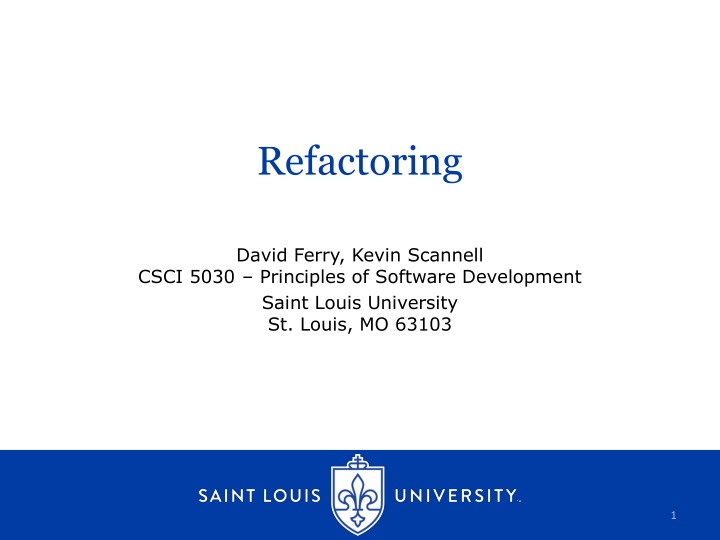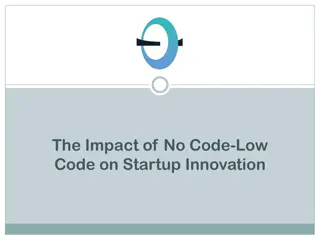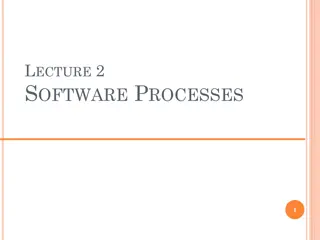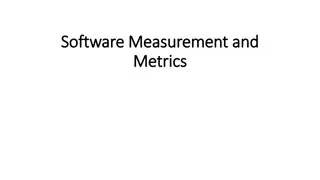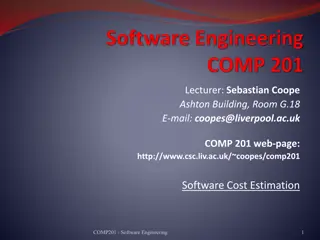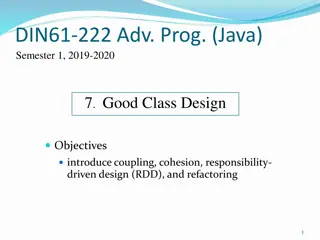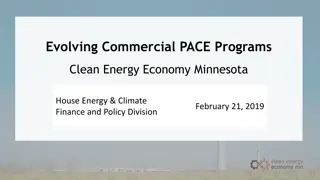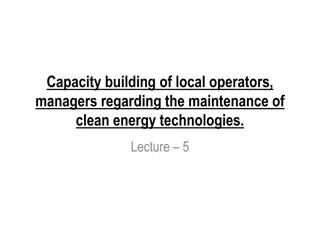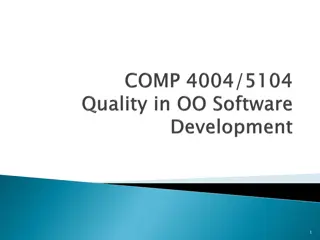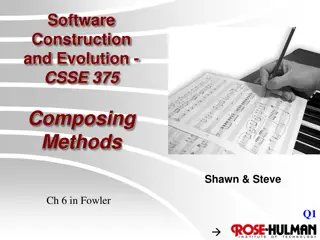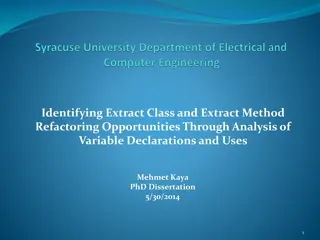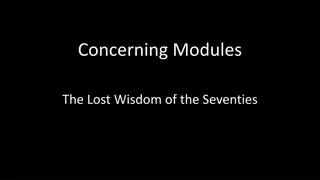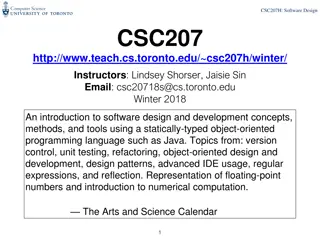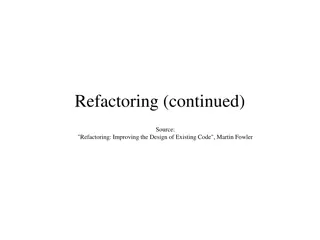Insights on Clean Code and Refactoring from Software Development Experts
Learn from renowned software development experts such as Bjarne Stroustrup, Grady Booch, Big Dave Thomas, and Michael Feathers about the importance of clean code and refactoring. They emphasize the significance of elegant, efficient, and maintainable code that enhances readability, minimizes bugs, and improves overall software quality.
Download Presentation

Please find below an Image/Link to download the presentation.
The content on the website is provided AS IS for your information and personal use only. It may not be sold, licensed, or shared on other websites without obtaining consent from the author.If you encounter any issues during the download, it is possible that the publisher has removed the file from their server.
You are allowed to download the files provided on this website for personal or commercial use, subject to the condition that they are used lawfully. All files are the property of their respective owners.
The content on the website is provided AS IS for your information and personal use only. It may not be sold, licensed, or shared on other websites without obtaining consent from the author.
E N D
Presentation Transcript
Refactoring David Ferry, Kevin Scannell CSCI 5030 Principles of Software Development Saint Louis University St. Louis, MO 63103 1
Goal of Refactoring Refactoring improving codebase without changing functional behavior Why? Architectural improvements Performance/scalability Fix non-functional bugs (e.g. memory leaks) Code maintenance and organization Reduce code complexity Eliminate code smells CSCI 5030 Principles of Software Development 2
Opinions on Refactoring Bjarne Stroustrup, inventor of C++ I like my code to be elegant and efficient. The logic should be straightforward to make it hard for bugs to hide, the dependencies minimal to ease maintenance, error handling complete according to an articulated strategy, and performance close to optimal so as not to tempt people to make the code messy with unprincipled optimizations. Clean code does one thing well. CSCI 5030 Principles of Software Development 3
Opinions on Refactoring Grady Booch, object-orientation guru Clean code is simple and direct. Clean code reads like well-written prose. Clean code never obscures the designer s intent but rather is full of crisp abstractions and straightforward lines of control. CSCI 5030 Principles of Software Development 4
Opinions on Refactoring Big Dave Thomas, Eclipse godfather Clean code can be read and enhanced by a developer other than its original author. It has unit and acceptance tests. It has meaningful names. It provides one way rather than many ways for doing one thing. It has minimal dependencies, which are explicitly defined, and provides a clear and minimal API. Code should be literate since depending on the language, not all necessary information can be expressed clearly in code alone. CSCI 5030 Principles of Software Development 5
Opinions on Refactoring Michael Feathers, refactoring guru I could list all of the qualities that I notice in clean code, but there is one overarching quality that leads to all of them. Clean code always looks like it was written by someone who cares. There is nothing obvious that you can do to make it better. All of those things were thought about by the code s author, and if you try to imagine improvements, you re led back to where you are, sitting in appreciation of the code someone left for you -- code left by someone who cares deeply about the craft. CSCI 5030 Principles of Software Development 6
Opinions on Refactoring Ward Cunningham, inventor of the wiki You know you are working on clean code when each routine you read turns out to be pretty much what you expected. You can call it beautiful code when the code also make it look like the language was made for the problem. CSCI 5030 Principles of Software Development 7
Themes Clean or not messy Readable Simple Minimal Straightforward Like with some other topics- you know it when you see it, but there is no checklist Refactoring is not tied to a specific style But, adherence to style makes code simple and direct and pretty much what you expected CSCI 5030 Principles of Software Development 8
When to Refactor Part of day-to-day programming is advised Boy scout principle leave code better than you found it If adding a new feature would be difficult, first refactor to make adding that feature easy, then write the feature Splits a big task into two or more smaller commits Verifies your architectural changes don t change behavior Assess new features after they re added and working- is there room for refactoring while everything is fresh in your head? When you struggle to understand code, refactor such that you wouldn t struggle next time CSCI 5030 Principles of Software Development 9
Code Refactoring Tools Commonly integrated into IDEs Many specific refactoring recipes (e.g. from Martin Fowler s book on refactoring) Tools are language-aware, e.g. ignore comments For example: Change function signature Parameter order, add extra parameter, etc. Extract as method Pulls highlighted code out into a new method, replaces with method call Extract superclass Pulls common methods and fields into a new class and subclasses existing objects to that superclass CSCI 5030 Principles of Software Development 10
Review Tools Remember that code review is a high-level cognitive task- automate where possible Turn on all compiler warnings, consider using warnings are errors flag Linters or other static code analyzers Style review and automatic formatting Non-error errors: uninitialized variable use, array bounds checking, dead code, null pointer dereference, etc. Dynamic (runtime) code analyzers Memory leak detection, concurrency and race conditions, invariant inference, performance and profiling, etc. Write your own tools for common problems CSCI 5030 Principles of Software Development 11
Example Linter Output https://engineering.fb.com/open-source/improving-css-quality-at-facebook-and-beyond/ CSCI 5030 Principles of Software Development 12
Case Study: Google Searching for Build Debt: Experiences Managing Technical Debt at Google by J. David Morgenthaler et al. Monolithic code repository (like Mozilla) Hundred-millions lines of code Single build system, CI system Upsides: Developers have access to entire source code Large scale code re-use, faster development Unified code review and indexing system CSCI 5030 Principles of Software Development 13
Case Study: Google Challenges: Easy to create large technical debt Difficult to make simple changes- rename class, change internal API Rapid code change- on average a dozen commits per minute Build system is managed manually: Dependency debt build dependencies are managed manually Visibility debt no notion of public or private APIs, so projects can depend on internal details of other projects CSCI 5030 Principles of Software Development 14
Google Technical Debt Solutions Automation tools to: Remove dependencies that are not actually used Find dependencies that are not declared Make it easy to do the right thing: Automatic tools to do refactoring on entire monolithic code base Make it hard to do the wrong thing: New default-private visibility settings that force teams to choose which APIs are public CSCI 5030 Principles of Software Development 15
Facebook Case Study Large, changing codebase, thousands of CSS files Traditional code reviews, style guidelines, and refactoring tools do not catch all mistakes Browsers ignore malformed CSS and give best- effort rendering, so many errors fail silently Old solution, regex based linter: Cryptic regex hard to understand or change Slow re-scan code for each regex Not always clear what causes failure CSCI 5030 Principles of Software Development 16
Facebook: Regex Insufficient Coming up with new regex rules for each problem encountered is just whack-a-mole Hard to write good rules to cover all bad formats can you spot three bugs in this code? { display: none: background_color: #8B1D3; padding: 10px,10px,0,0; opacity: 1.0f; } CSCI 5030 Principles of Software Development 17
Facebook: Regex Insufficient Coming up with new regex rules for each problem encountered is just whack-a-mole Hard to write good rules to cover all bad formats can you spot three bugs in this code? { display: none: background_color: #8B1D3; padding: 10px,10px,0,0; opacity: 1.0f; } 1. Underscore in property name Consider all properties with a dash in the name 2. Hex color is too short 3. Comma separators should be spaces Again, consider all possible properties with this pattern CSCI 5030 Principles of Software Development 18
Facebook Case Study Solution, abstract syntax tree parser: Existing tools can create the AST for you Each property becomes a node in the AST with a value Catches invalid syntax automatically Test cases are much simpler and clearer: if ( node.prop === 'text-transform' && node.value === 'uppercase') { error( Not internationalization-friendly ); } If ( warn( Performance: this property is slow ); } node.prop === opacity ){ CSCI 5030 Principles of Software Development 19
